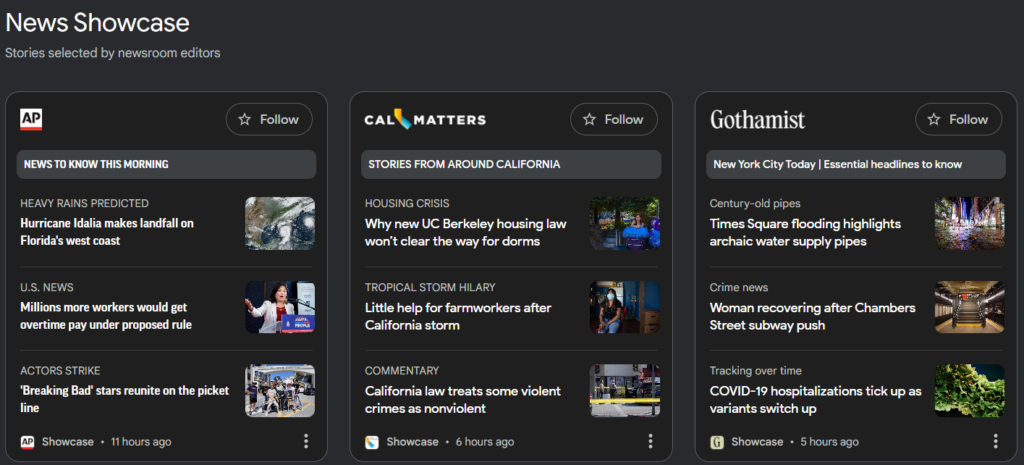Optimizing content for Google’s news surfaces can be a great way to reach more readers interested in timely stories and assert your brand’s topical authority online. As Google expands its news initiatives, we see new opportunities for publishers to earn visibility, including Google News, Google Discover, Top Stories, and other news search engine results page (SERP) features.
To many writers and publishers, seeing success in Google News may not be as intuitive as the news reporting process. However, taking the time to implement some key best practices can significantly help your news site gain visibility and readership through Google’s news surfaces.
According to Amsive’s Senior SEO Director, Lily Ray, timeliness is everything for news content. However, we know Google’s news products depend on several other signals in determining the best story to satisfy users.
While Google Search requires an explicit query – a search term that clearly and directly states what a user is looking for online – other news surfaces are more reliant on locality, originality, topical authority, and user data, depending on intent. Google’s guidelines around Experience, Expertise, Authority, and Trust (E-E-A-T) are an important consideration for news publishers looking to optimize their content for search engines.
As marketers, it’s important to understand how to optimize for E-E-A-T because it plays a key role in how Google evaluates a news site’s overall quality and authority. Focusing efforts on improving your site’s expertise, author credibility, depth of content, and other E-E-A-T factors can directly help increase visibility in Google News and other news-related search features.
In this post, we address fundamental ways to improve your site’s appearance on Google’s news surfaces. We will shed light on Google News features that have received updates, like Top Stories, News Showcase, and News Topic Authority, and provide actionable tips to optimize your website.
A Breakdown of Google’s News Ecosystem
Before jumping into specifics on optimizing for Google’s news surfaces, it’s helpful to first understand the landscape of Google’s news products. This background will allow us to better grasp how changes to platforms like News Showcase and the Google News app can impact publisher visibility.
Google refers to its suite of news products as “news surfaces.” These include well-known platforms like Google News and Top Stories, as well as newer ones like Google Perspectives, Google Discover, and News Showcase.
Before diving into a breakdown of Google’s News products, let’s clear up one common source of confusion by answering the question, “What is the difference between Google News and the Google Search News Tab?”
Despite the similar names, these refer to two distinct products. The corresponding traffic data is found in separate areas of your Google Search Console. Google touches on the difference between these in their article on how to appear on other news surfaces.
Google News vs. Google Search News Tab
You can access Google News at its own website or via the Google News app. Our focus in this post will be optimizing specifically for Google News search results, rather than the Google Search news tab.
When you land on the Google News homepage, you’ll notice various tabs like “Top Stories,” “Following,” and “News Showcase.” We’ll explain what each of these means and how to optimize for them later on.

Find your site’s Google News traffic report on the left-hand side of Google Search Console under Performance > Google News. This report will only appear if your site has received Google News traffic during the selected time period.

The Google Search News Tab, or News Tab, shows all news stories that rank through organic search when the user clicks the “News” tab.

You’ll find Google Search News Tab traffic on the left-hand side of Google Search Console under Performance > Search Results > Search Type > Filter > News.
Please note: This is Google Search traffic, not Google News traffic.

Top Stories: The Prime Real Estate
The “Top Stories” surface populates at the top of Google’s organic search results on desktop and mobile for queries related to timely events.

The Top Stories carousel no longer requires AMP for inclusion in mobile results. This is an update that came with the implementation of page experience ranking signals in 2021.
Page experience and Core Web Vitals continue to see regular updates, but the crux is the same: Google’s algorithm prioritizes quick-rendering pages.
Getting into Google’s Top Stories may be more challenging for low-circulation publishers, but leaning on original reporting will promote brand awareness and topic authority, which are required to appear in Top Stories.
News Showcase: The Curated Experience
The News Showcase was launched in 2020 to Brazilian and German audiences. In 2023, Google announced it would be releasing the product to the U.S.
News Showcase is invite-only and was originally limited to around 150 news publications. As of June 2023, there are more than 2,300 publications across 22 countries in the News Showcase.
This consists of a “showcasing” of three stories from the Google newsroom-selected publishers. The News Showcase was created to help Google strike deals with publishers so the search engine could generate revenue from newsroom content.

However exclusive this surface may be, other routes like the follow button and Google Perspectives have a lower barrier to entry.
Setting intermediary goals for increasing news follows could be a good starting point in aiming to have your site eventually placed in Top Stories and the News Showcase.
Embrace the Follow Button
Google announced an update to its “Following” tab in Google News alongside the 2023 News Showcase announcement. You can access a site’s follow button in the Google News app and a site’s publisher page. In addition, sites have the opportunity to promote the follow button for stories reached via Google Discover. We discuss this surface in the “Google Discover” section.
Steps to follow a publisher from Google News App:
- Click the three dots at the bottom-left corner of the story
- Click “Go to [publisher’s name]”
- Select the blue star at the top right of the publisher’s name
- Confirm you are following with the pop-up

Steps to follow a news publisher from Google News desktop:
- In Google News, search for the publisher’s name
- Select the publisher with “Source” below the name
- Select the blue star to the right of the publisher’s name

Including calls-to-action for readers to navigate to Google’s follow feature may improve your site’s chances of appearing higher and more regularly to interested audiences.
How Search Generative Experience (SGE) Impacts Google News
A recent X post by Lily Ray touches on how the full rollout of Google’s Search Generative Experience (currently in beta testing) might impact news-seeking behaviors on the SERP.
In-text citations to original sources could pose a challenge to publishers as SGE stands. In the example below, searchers do not have to click into Nogood.io or Influencer Marketing Hub to identify the source of the information – clicking into the SGE panel provides information outright.

As an upside, the links in these footnotes present a traffic opportunity similar to that of Bing Chat’s in-text links.

Google Discover
Google mentions Discover on its list of News surfaces. Known as “query-less search,” Google Discover offers up a set of stories tailored to the user’s interests and location.
Google Discover is only available on mobile devices, including Android phones, iPhones, and iPads, from the Google Search app or web browser.

Discover performance can be tracked in Google Search Console under the Discover report. This report shows impressions, clicks, and click-through rates for articles that appeared in Discover.

Google’s Search Central Blog offers guidance to sites looking to promote the follow button in Google Discover. Like the Google News following feature, this feature creates a tailored feed.
Sites can use an RSS or Atom feed to help Google identify the content category. Keep this feed updated, include titles, and ensure the URL isn’t blocked with the robots.txt file.
Google Perspectives
Google Perspectives, like the News Tab, is a news SERP feature. Originally launched in May 2023, this feature is present on select queries where personal experience (related to the new experience “E” in E-E-A-T) would be helpful in forming a takeaway.

For Google’s news surface, the perspectives feature appears when multiple editorial perspectives are needed for a balanced story.
From the Google Blog post, Five new ways to verify info with Google Search:
“This carousel will appear below Top Stories and showcase insights from a range of journalists, experts, and other relevant voices on the topic you’re searching for. This feature will give you a variety of noteworthy voices on a news topic, complementing the trustworthy reporting you already find on Search to help broaden your understanding.”

Google News Optimization Strategies
Now that we’ve covered Google’s suite of news surfaces, we will address strategies to increase your chances of getting your stories to appear in them.
News Topic Authority Overview
Google updated its guidance on how it evaluates topic authority in search rankings in May 2023. Topic authority refers to how knowledgeable and trustworthy a site is perceived to be on a given topic. The following are the three main signals Google looks at when considering topic authority.
Source notability: How relevant the topic is to the publisher. For example, The New York Times has authority over national news, while Buzzfeed has authority over pop culture and media.
Influence and original reporting: The amount of original and influential information contained on a page. Being the first to break a news story and receiving many backlinks signals strong influence. Google may add a “Highly Cited” label to indicate original reporting.
Source reputation: Factors like awards, accreditations, expert authors associated with a publication, and affiliations with authoritative organizations add to source reputation.
Identifying News Topic Authority
To identify where you have topic authority, look at Google Search Console and Analytics reports to see ranking and traffic patterns. Third-party backlink tools can also provide clues about influential content based on backlinks received and their anchor text
To optimize existing authority, focus on creating timely, original content from experienced writers with expertise in their area of focus. You should also promote your high-authority content on your social channels.
Changing News Topic Authority
To move into a new topic area, consider working with writers who have expertise in that niche and build citations through high-quality content. Transition gradually to avoid sending confusing signals to users and search engines.
When possible, use old content as a launch pad to weave into the new topic authority. Track performance in Google Search Console and Analytics to monitor progress, as advised above.
Google Publisher Center
Google Publisher Center allows you to define news categories that align with your site’s sections. Follow Google’s guidelines on connecting and managing sections, and upload your RSS or Atom feed URL to Google Publisher Center.

Include these categories in your sitemap and consider using clear /news/ subfolders in URLs. Filtering by subfolder can ease tracking efforts, but it’s not as necessary as connecting content through the Publisher Center section.
News XML Sitemaps
Google recommends news sites create and submit a News XML sitemap in addition to their general sitemap.
Your news sitemap will hold timely (48-hour) content with supplemental information on the publisher, publish date, language, and title.
You can reference the full list of guidelines that a news sitemap should follow in Google’s Search Central Blog Post on News Sitemaps, but we’ve created a quick-start guide below to get you started.
- Include news stories that have been published in the last 2 days only. Stories older than 2 days should be removed from the news sitemap automatically.
- The sitemap needs to be updated with new posts as soon as they are published.
- The sitemap can include up to 1,000 URLs. If there is a need to have over 1,000 URLs published in a news sitemap, then they need to go into a second news sitemap.
- Submit your news sitemap via GSC and Google Publisher Center.
- List the sitemap URL on your site’s robots.txt file.
Author Bylines on News Surfaces
In June 2023, Google started testing showing author names in Top Stories within Google Search. As of September 2023, users have seen author bylines tested in both Top Stories on Search and Google News and in Google Discover.

This is another signal of Google’s shift to emphasizing E-E-A-T signals on the SERP. Lily Ray advised publishers on how to optimize for these changes in a recent X post.
NewsArticle Structured Data
While there is no markup required to make your blog or article appear in Google News or Top Stories, the following structured data helps Googlebot understand your article.
Google calls out three article types from schema.org: Article, NewsArticle, and BlogPosting.
The Google Search Central Blog shares insight on the value of adding NewsArticle structured data.
Using JSON (Google-prefered format) or microdata, publishers can set modification dates (especially important for breaking news), authors, and images. As mentioned above, these signals are increasingly important for publishers.
Embedding high-quality images with relevant alt text can improve your chances of having an image appear in a Top News or Image Carousel. Google advises including images with multiple aspect ratios, including 16×9, 4×3, and 1×1.
Note on dateModified and Artificial Refreshing
Google advises publishers against updating the dateModified schema or on-page references to an update without “adding significant information.” This is a policy violation in Google News which can put your site at risk of receiving a manual action.
Google News Mistakes to Avoid
There are several pitfalls we have seen publishers fall into which Google has explicitly denounced across Google news surfaces.
- Steer clear of wordy, overly optimized headlines. Simple subject-verb-object headlines with relevant keywords tend to perform best.
- Do not change on-page or structured data references to the date updated or modified without substantial changes to the content.
- Do not borrow or steal content without citations, and consider implementing canonicals or noindex for republished work.
- Do not publish duplicate content across your website.
- Avoid deceptive practices in headlines or in reporting – do not mislead your audience.
- Provide transparency signals about your publication and your authors.
Next Steps in Navigating Google’s News Surfaces
Optimizing for Google’s news surfaces presents an opportunity for publishers to expand their reach and solidify topic authority. While getting into exclusive features like News Showcase or Top Stories may be unrealistic for smaller outlets, following best practices around news sitemaps, structured data, and original reporting will move the needle.
Remember to monitor Google Search Console and Google Analytics to identify strengths, and double-down on publishing high-performing content to social channels and contributor expansion. For publishers looking to transition to a new focus area, take a gradual, metrics-based approach to changing perceived authority.
Ready to give your site’s traffic a boost with Google News? Dig deeper into what it means to outperform your publisher site competition, or let’s talk about how to achieve more for your marketing — and your business.






